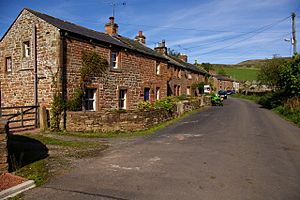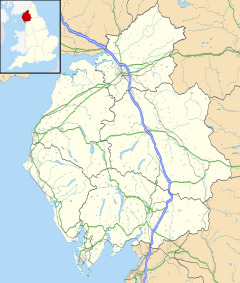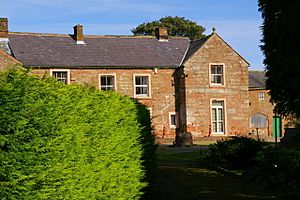Croglin facts for kids
Quick facts for kids Croglin |
|
|---|---|
| Village | |
 Croglin |
|
| OS grid reference | NY572471 |
| Civil parish | |
| Unitary authority |
|
| Ceremonial county | |
| Region | |
| Country | England |
| Sovereign state | United Kingdom |
| Post town | CARLISLE |
| Postcode district | CA4 |
| Dialling code | 01768 |
| Police | Cumbria |
| Fire | Cumbria |
| Ambulance | North West |
| EU Parliament | North West England |
| UK Parliament |
|
Croglin is a small, beautiful village in Cumbria, England. It sits quietly between the Pennines (a range of hills) and the River Eden. This peaceful spot is about 14 miles south-east of Carlisle.
The land around Croglin is mostly used for farming, especially raising sheep. A small river, called Croglin Water, flows through the valley. It eventually joins the larger River Eden. In 1931, about 198 people lived in the area.
Contents
Welcome to Croglin Village
Croglin has been a village for a very long time. It might have even started as two smaller settlements. There has been a church here since the Norman times. The church you see today, named for St. John the Baptist, was built in 1878.
Today, Croglin has a post office that opens a couple of mornings each week. There is also a friendly local pub called the Robin Hood.
Protecting the Village
Because Croglin is close to the Scottish border, it faced many attacks in the 1400s. These attacks were carried out by groups called the Border Reivers. To protect themselves, people built strong towers.
A part of one of these old towers, called a pele tower, still stands today. It is now part of a house known as The Old Pele. This old building shows how important it was to defend the village long ago.
Local Businesses and Products
Croglin is also known for a few local businesses. A company called Croglin Toys started here in 1980. They now make toys from a nearby village called Lazonby.
Another local business is Thornby Moor Dairy. This dairy began in 1979. They make a special kind of cheese from sheep's milk. It is famously known as Croglin Cheese.
Croglin's Past
The name Croglin likely comes from old words. It might mean "bend" and "torrent," describing the winding river. Another idea is that it comes from words meaning "abrupt hill" and "pool." Both ideas fit the village's location.
On April 1, 1934, Croglin's local government area was changed. It became part of a larger area called Ainstable. Some parts also joined Cumrew.
The Croglin Vampire Story
There is a famous old tale about a vampire connected to the Croglin area. This story has many different versions. It is said to have happened in 1874. However, there are no records of this event before the 1900s.
One author claimed he heard the story in 1874. But he did not share it publicly until many years later. The family members of the person who supposedly saw the vampire later believed the story was true. Some details in the story do not quite match how the area was in the 1870s.
Most people believe this vampire story is a fun piece of fiction. It might have been a simple anecdote that grew into a much bigger tale. Or it could be a very exaggerated version of a real event that happened long ago. It remains a popular local legend!



